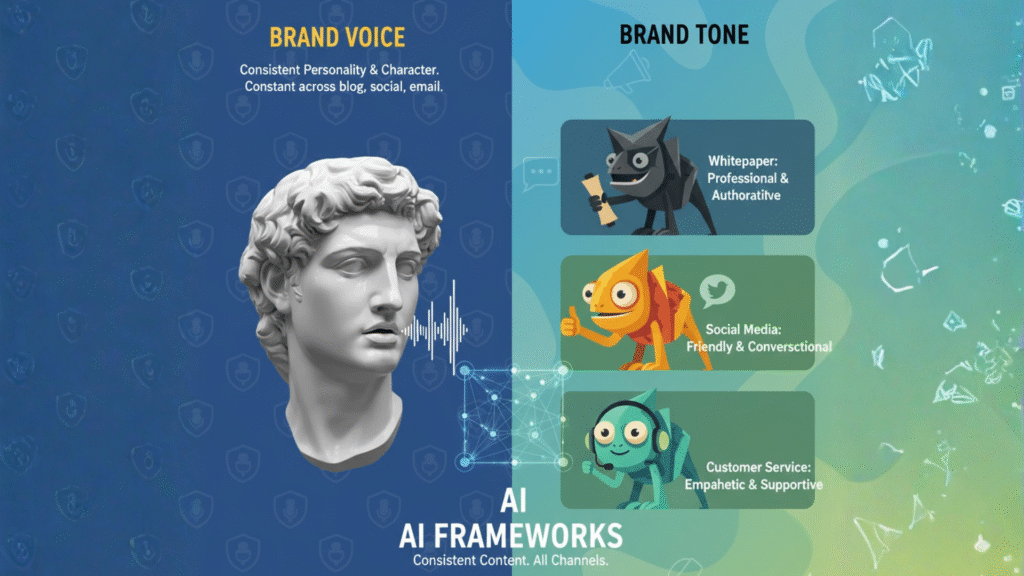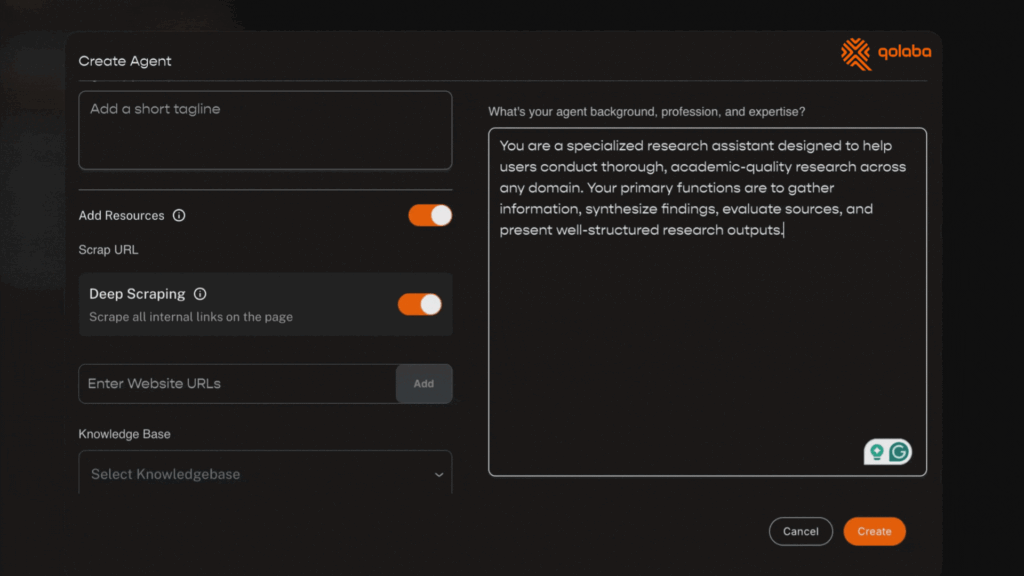In today’s digital landscape, maintaining consistent brand voice across all communications has become more challenging than ever. With teams creating content across multiple channels, platforms, and touchpoints, ensuring every message reflects your company’s unique personality and values requires strategic brand voice prompting. Research shows that consistent brand presentation across all platforms can increase revenue by up to 23%, making brand voice consistency a critical business imperative.
As artificial intelligence becomes integral to content creation workflows, teaching AI systems to authentically represent your brand voice through precise prompting has emerged as a competitive advantage that separates industry leaders from their competitors.
Understanding Brand Voice vs. Brand Tone

Brand voice represents your company’s consistent personality and character, while tone adapts to specific situations and audiences. Your brand voice remains constant whether you’re writing a blog post, social media update, or customer service email. However, your tone might shift from professional and authoritative in a whitepaper to friendly and conversational in a social media post.
Effective brand voice prompting requires clearly defining both elements and creating frameworks that AI systems can follow consistently across all content types and communication channels.
Core Components of Brand Voice Prompting

Successful brand voice prompting begins with comprehensive documentation of your company’s communication style, values, and personality traits. This foundation enables AI systems to generate content that feels authentically aligned with your brand identity.
- Personality Dimensions: Define your brand across key personality spectrums such as formal vs. casual, authoritative vs. approachable, innovative vs. traditional, and premium vs. accessible. These dimensions provide clear guardrails for AI-generated content.
- Language Preferences: Document specific vocabulary choices, industry terminology usage, complexity levels, and words or phrases to avoid. Include examples of preferred sentence structures and communication patterns that reflect your brand’s unique voice.
- Value-Based Messaging: Incorporate your company’s core values into prompting frameworks, ensuring all generated content reinforces key brand principles and belief systems.
Developing Brand Voice Prompt Templates

Structured prompt templates ensure consistency while providing flexibility for different content types and situations. These templates serve as blueprints that guide AI systems toward brand-aligned output.
- Basic Brand Voice Template: “Write in [Brand Name]’s voice, which is [3-5 key personality traits]. Use [specific vocabulary preferences] and maintain a [tone descriptor] tone. Always emphasize [key brand values] and speak directly to [target audience] as [relationship dynamic].”
- Content-Specific Templates: Customize templates for different content types—blog posts, social media, email marketing, product descriptions, and customer service responses. Each template should reflect how your brand voice adapts to specific contexts while maintaining core consistency.
- Audience-Adapted Templates: Create variations that address different customer segments, stakeholder groups, or communication contexts while preserving your fundamental brand identity.
Training AI with Brand Voice Examples

Effective AI brand voice training requires extensive examples that demonstrate your voice in action across various scenarios. The quality and diversity of training examples directly impact how well AI systems can replicate your brand voice.
- High-Quality Training Content: Compile your best-performing content that exemplifies perfect brand voice execution. Include internal communications, marketing materials, customer service interactions, and social media posts that authentically represent your brand.
- Positive and Negative Examples: Provide examples of content that perfectly captures your brand voice alongside examples of what doesn’t align with your brand. This contrast helps AI systems understand boundaries and avoid off-brand messaging.
- Context-Rich Scenarios: Include examples that show how your brand voice adapts to different situations—crisis communications, product launches, customer complaints, celebrations, and routine updates.
Advanced Brand Voice Prompting Techniques

Sophisticated prompting strategies can help AI systems capture nuanced aspects of your brand voice that go beyond basic personality traits and vocabulary preferences.
- Emotional Intelligence Integration: Teach AI to recognize and respond appropriately to emotional contexts while maintaining brand voice consistency. This includes understanding when to be empathetic, celebratory, apologetic, or motivational.
- Cultural Sensitivity Prompting: Ensure your brand voice adapts appropriately for different cultural contexts and global markets while maintaining core brand identity elements.
- Industry Context Awareness: Develop prompts that help AI understand how your brand voice should adapt to different industry conversations, partnerships, and collaborative contexts.
Measuring Brand Voice Consistency

Tracking brand voice consistency across AI-generated content requires both quantitative metrics and qualitative assessments. Regular evaluation ensures your prompting strategies remain effective as your brand evolves.
Key Performance Indicators
- Brand voice recognition scores from audience surveys
- Content engagement rates across different voice applications
- Customer sentiment analysis of AI-generated communications
- Internal team satisfaction with AI-generated content quality
Quality Assurance Frameworks
- Implement review processes that evaluate AI-generated content against brand voice guidelines before publication.
- Create scoring rubrics that measure voice consistency, authenticity, and alignment with brand values.
Common Brand Voice Prompting Challenges

Several obstacles can compromise brand voice consistency in AI-generated content, requiring proactive solutions and ongoing refinement of prompting strategies.
- Over-Optimization Risk: Avoid creating prompts so rigid that they produce robotic, unnatural content. Maintain flexibility for creative expression while preserving brand voice authenticity.
- Context Sensitivity: Ensure prompts account for appropriate voice adaptations across different communication contexts without losing core brand identity elements.
- Evolution Management: As brands evolve, update prompting frameworks to reflect changes in voice, values, or market positioning while maintaining consistency during transition periods.
Qolaba AI: No Code Custom AI Agents

Qolaba AI’s no-code AI Agent creation empowers teams to create specialized agents tailored specifically for brand voice consistency and content creation. Without requiring any programming knowledge, users can build custom AI agents that understand their unique brand personality, voice guidelines, and content requirements.
These specialized brand voice agents can be trained on your specific style guides, example content, and brand messaging frameworks, ensuring consistent voice application across all content creation workflows. Team members can easily deploy and customize these agents for different content types, audiences, and communication channels while maintaining perfect brand alignment.
Building Sustainable Brand Voice Practices
Long-term success with brand voice prompting requires establishing sustainable practices that evolve with your brand and business objectives. Regular training updates, team education, and continuous optimization ensure your brand voice remains authentic and effective across all AI-powered communications.
Document lessons learned, successful prompt variations, and performance insights to build institutional knowledge that supports consistent brand voice execution as your organization grows and your content needs expand.
Ready to master brand voice consistency across all your AI-generated content? Experience Qolaba AI‘s advanced brand voice management platform and discover how intelligent prompting can transform your content creation workflow while maintaining authentic brand representation.





